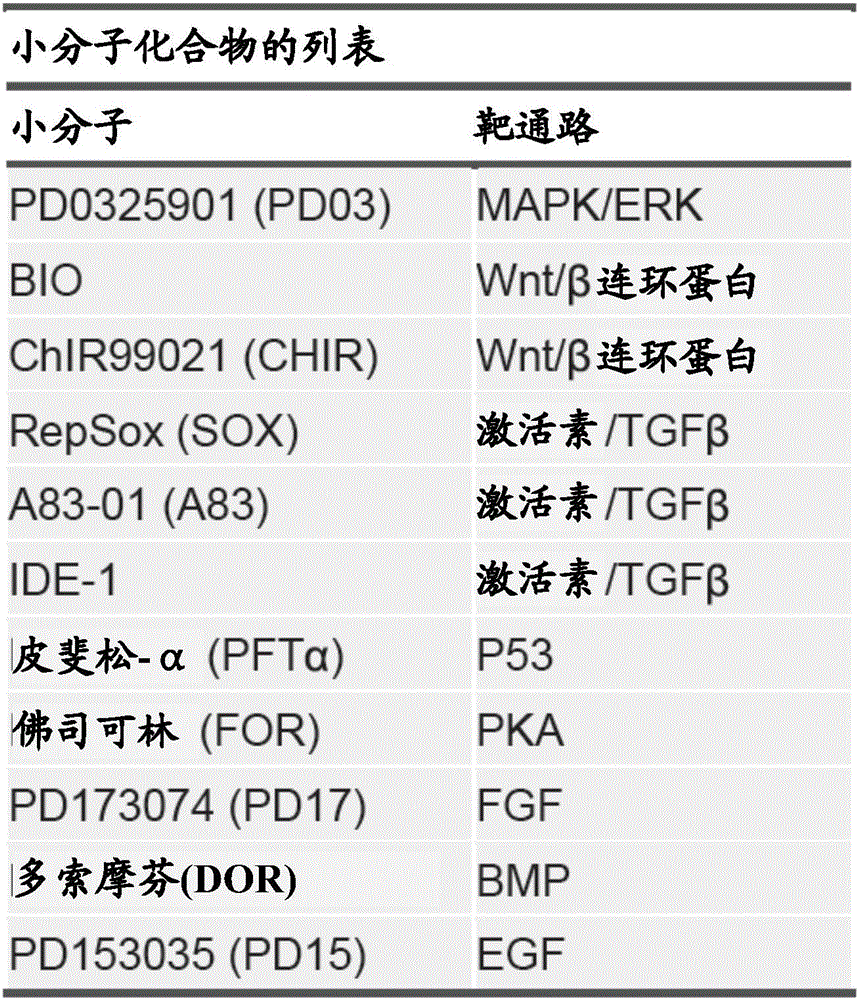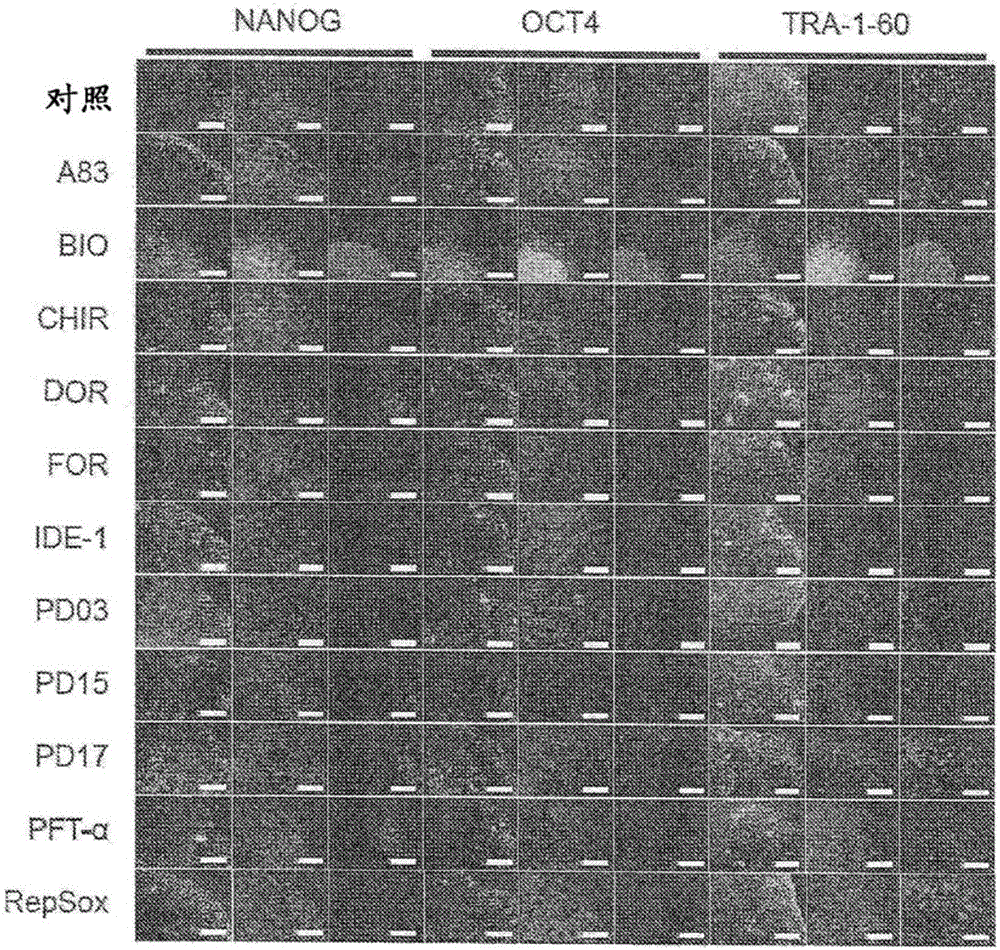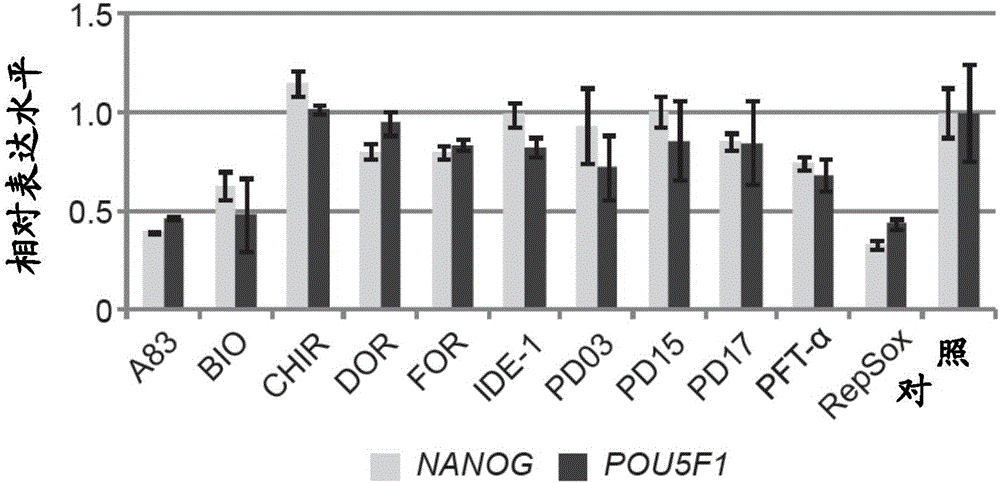Culturing pluripotent stem cells
A technology of pluripotent stem cells and feeder cells, which is applied in the field of culturing and maintaining pluripotent stem cells in an undifferentiated state, and can solve problems such as limitations and differences
- Summary
- Abstract
- Description
- Claims
- Application Information
AI Technical Summary
Problems solved by technology
Method used
Image
Examples
Embodiment 1
[0201] Combinations of small molecules induce unique hESC states
[0202] To induce an alternative hESC state potentially closer to the preimplantation ectoderm state in vivo, 11 small molecules targeting 8 signaling pathways were used to screen for conditions that increased NANOG expression ( Figure 1A). NANOG is used as a definitive marker in the separation of pluripotent ectoderm from endoderm in the inner cell mass of preimplantation embryos. Nanog levels in mouse blastocysts decrease during implantation, suggesting that Nanog levels reflect different states of pluripotency. NANOG expression was also enriched in human native preimplantation ectoderm compared with hESC. The effects of these inhibitors were first studied individually. Although the majority of small molecule-treated cells stained positive for hESC markers, they did not exhibit changes in their morphology or induce upregulation of the NANOG transcript ( Figure 1B -C). Therefore, then using a combination...
Embodiment 2
[0205] Active LIF signaling in 3iL hESCs
[0206] In contrast to conventional hESCs which do not rely on LIF signaling, LIF appears to be necessary for the self-renewal of 3iL hESCs. To further investigate the role of LIF in 3iL hESCs, a Jak inhibitor (inh) targeting the LIF signaling pathway was used. Treatment of 3 iL hESCs with a Jak inhibitor induced a decrease in the expression of pluripotency markers and a strong decrease in the number of colonies ( Figure 3A -B). Gene expression of NANOG and LIF signal transduction responsive genes KLF4 and SOCS was reduced ( Figure 3C ). These results further suggest that LIF signaling is required for the maintenance of hESCs.
[0207] LIF signaling can be induced in hESCs. However, in contrast to 3iL hESCs, LIF was not essential for hESC self-renewal. To investigate the reason for the difference in LIF requirement, LIF signaling activity in these two cell states was compared. In hESCs, transcripts for GP130, a co-receptor ess...
Embodiment 3
[0210] 3iL hESCs exhibit hallmarks of pluripotency
[0211] Characterization was performed below to determine whether these 3iL hESCs were indeed pluripotent. The cells stained positively for the pluripotency markers OCT4, NANOG, TRA-1-60 and TRA-1-81 ( Figure 5A ). Transcript levels of pluripotency markers remained comparable between 3iLhESCs and untreated hESCs ( Figure 5B ). 3iL hESC maintained a 2-fold higher level of NANOG expression ( Figure 5B ), which is also reflected at the protein level ( Figure 5C ). Interestingly, upregulation of ectoderm-specific genes including DPPA3 and TBX3 was observed in 3iL hESCs ( Figure 5B ). Fluorescence-activated cell sorting (FACS) analysis revealed that 3iL hESCs express OCT4 clearly and have significantly increased levels of NANOG, TRA-1-60 and TRA-1-80 ( Figure 5D ).
[0212] Subsequently, it was investigated whether 3iL hESCs could differentiate into all germ lineages. 3 iL hESCs form large embryoid bodies that can ...
PUM
 Login to View More
Login to View More Abstract
Description
Claims
Application Information
 Login to View More
Login to View More - R&D
- Intellectual Property
- Life Sciences
- Materials
- Tech Scout
- Unparalleled Data Quality
- Higher Quality Content
- 60% Fewer Hallucinations
Browse by: Latest US Patents, China's latest patents, Technical Efficacy Thesaurus, Application Domain, Technology Topic, Popular Technical Reports.
© 2025 PatSnap. All rights reserved.Legal|Privacy policy|Modern Slavery Act Transparency Statement|Sitemap|About US| Contact US: help@patsnap.com



